Gorilla trekking in Uganda is a once-in-a-lifetime activity you will cherish for eternity.
South Western Uganda is one of the most beautiful areas in Uganda. The endless magnificently rolling hills and valleys intertwined are such a beauty to look at. One of my old friends used to joke that during creation, God concentrated more on the Southwestern part of the country. Once he was satisfied with his creation, he decided to do a little work for the rest of Uganda, but unfortunately, he must have been a little tired…ha-ha…yes! It is that magnificent!
Why choose Uganda for Gorilla trekking?
On your way to Bwindi Impenetrable Forest, you will be awed and amazed by the beautiful landscape. Rolling hills and lush green vegetation and valleys characterize the area.
Biggest number of mountain Gorillas in the world
It is estimated that Uganda is home to more than 480 mountain gorillas which make up more than half of the total population of mountain gorilla there is in the entire world. These are spread across two national parks in Uganda, Bwindi National Park and Mgahinga National Park. The chances of encountering gorillas in huge numbers are much higher within Uganda than anywhere else.
Authentic experience
Uganda is privileged to have these rare creatures and does not take this for granted. Uganda Wildlife Authority tries to keep the Gorilla trekking experience authentic by managing the number of visitors issued gorilla trekking permits on any given day. Currently, 190 permits are issued per day. This helps to avoid overcrowding and leaves room to maintain the authenticity of the trekking activity
Diverse habitat
The Gorilla trekking areas in Uganda are characterized by varied vegetation. Bwindi’s impenetrable forest is made up of compact rainforests, uneven terrain, and steep valleys. It has been designated as a UNESCO World Heritage site. Mgahinga National Park on the other hand is located in the Virunga volcanic range and is characterized by a mixture of bamboo trees and open fields.
Many Trekking routes
Uganda offers various trekking routes thus visitors have an opportunity to choose which route they prefer depending on their preference for short of long trek, adventurous, or challenging treks.
Incomparable Wildlife Viewing
Uganda offers an abundance of other wildlife species apart from gorillas. Uganda is considered the primate capital of the world. It offers plenty of opportunities to view golden monkeys, chimpanzees, and so many more species. It is also a haven for bird enthusiasts with more than 1000 bird species, including the rare types like the shoebill stork.
Opportunity for cultural engagement
Gorilla trekking in Uganda provides an opportunity to interact with the local community and get an insight into their traditional beliefs and way of life. Community walks are usually organized after the trek and visitors are encouraged to participate in some community-engaging activities.
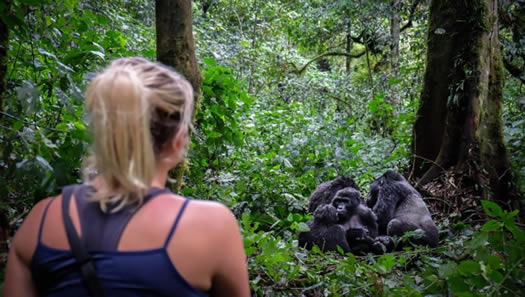
Gorilla Permit Requirements and Process
Gorilla Permit
A Gorilla permit is a mandatory requirement for everyone intending to trek Gorillas in Uganda. Each permit allows one person to trek in a designated area for one whole day. It is important to note that Gorilla permits book out fast, so it is advisable to book well in advance.
Reservation Process
Gorilla permits can be obtained through the Uganda Wildlife Authority and authorized tour operators. It is advisable to book Gorilla permits through a reputable tour operator company that will help with transportation and organizing the logistics of your entire trekking experience. Africa Moja Safaris is the number one and most reputable tour operator company.
Advance booking and Permit Cost
Gorilla permits for foreigners currently cost $800; East Africans have a different rate. Due to the huge demand for permits, it is advisable to book your permit months in advance to ensure proper planning.
Identification will be requested when booking your Gorilla permit and you are advised to be flexible with dates when booking your permit.
BEST TIME TO GO GORILLA TREKKING IN UGANDA
Although gorilla trekking is feasible all year round, different seasons provide superior trekking and wildlife viewing opportunities. For a successful and pleasurable gorilla trekking adventure in Uganda, timing is important.
Dry Season (December to February & June to September):
In Uganda, the dry season is said to be the ideal period for gorilla trekking. The weather is usually nice during this time of year, with less rain and clearer skies. Trekking is more comfortable because the routes are simpler to follow and drier. Additionally, because animals congregate near water sources and the foliage is less dense, making vision easier, wildlife observations are frequently better.
Wet Season (March to May & October to November):
Often referred to as the “low season,” Uganda’s wet season offers benefits and things to keep in mind when going on a gorilla trekking expedition. Despite the increased frequency of rains during this time of year, the extraordinarily lush and vivid landscapes make for wonderful photo backgrounds. Additionally, the forest is denser, which may make gorilla sightings somewhat more difficult. The low season does have certain benefits, though, like fewer visitors, cheaper permit costs, and the chance to see newborn gorillas playing in the rainforest.
Shoulder Season: January through February and September through October:
In Uganda, January and February, together with September and October, are regarded as the shoulder seasons. These times provide a harmony between the moist and dry. seasons, when there are fewer people and generally pleasant weather. Less expensive permits, comparatively fewer visitors, and comfortable hiking weather are available to visitors.
The ideal time of year to go gorilla trekking in Uganda ultimately comes down to personal opinion. The dry season can be your best option if you want simpler trekking conditions and dryer weather. On the other side, the wet season can provide a singular and fulfilling experience if you appreciate verdant surroundings and don’t mind the odd downpour.
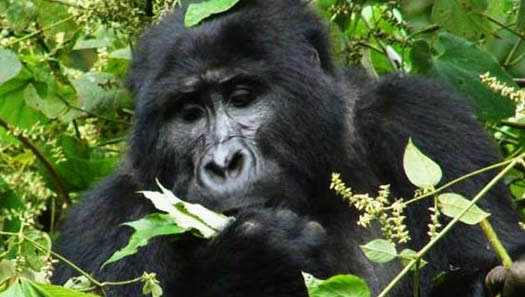
What to pack for Gorilla trekking
- Hiking boots
- Waterproof jacket
- Quick drying clothes
- Sunscreen and hat
- Water and snacks
- Camera and extra batteries
- Binoculars
- First aid kit
Journey to Bwindi National Park for Gorilla trekking in Uganda
As you drive by you will notice the small paddocks of cultivated land along the hills. Agriculture is one of the main activities carried out in most rural areas of Uganda. The indigenous people of Uganda mainly practice farming and animal keeping as a way of living.
The journey to Bwindi is quite long and many people often opt to fly into Bwindi which highly decreases the hours spent in transit. However, for a first-time visitor to Uganda, we recommend the long tedious journey by road because it gives one a full view and feel of the beauty of Uganda, from the beautiful landscape to the rich culture of the people. Witnessing the daily activities of the people in the different villages as the safari car passes by gives the visitor an insight into the life of the locals in different rural areas of the country. From Kampala to Bwindi the journey takes roughly 10 hours by road. By the time you get to Bwindi, you will be tired but believe me, it is worth every memory of the beautiful journey.
Gorilla trekking is one of those surreal experiences that you will experience once in a lifetime. You have to do it to understand the feeling and impact. Meeting these gentle human-like giants in their natural home in the deep canopies of Bwindi Impenetrable forest is extremely thrilling and a deeply humbling experience that will be cherished for a lifetime.
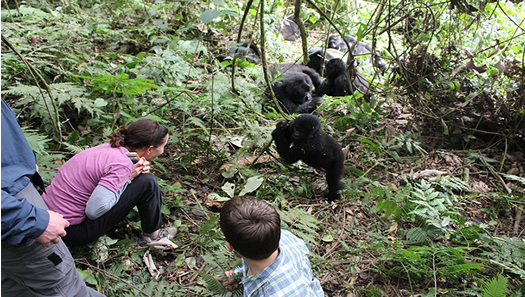
Gorilla trekking day
Your big day (that is the gorilla trekking day) starts early in the morning, after an early breakfast at your designated lodge/hotel. Everyone will be gathered at the meeting point; each trekking route has a designated meeting point. This is the point where everyone meets up and a briefing is done by your trekking guide before embarking on the trek.
Uganda has two main Gorilla trekking areas, Bwindi National Park and Mgahinga National Park. The trekking routes within Bwindi are divided into 4 sectors. Each provides a unique experience to the visitors. These include Rushaga(Southern Bwindi), Buhoma (Northern Bwindi), Nkuringo (Southern Bwindi), and Ruhija (Eastern Bwindi). Each of these sectors has several habituated gorilla families that are trekked, some regions have 5 families while others have more or less than five. Currently, 5 new gorilla families have completed their 4 year habituation period and have been introduced into the different gorilla trekking regions in 2024. Up to 190 gorilla permits can now be issued for trekking per day as of 2024.
As your gorilla trekking journey starts, a few ground rules will be relayed by your guide for the trek. These will include;
- Maintaining a safe distance from the gorillas
- No feeding or touching the gorillas. Gorillas are very sensitive to human bacteria and thus can easily be infected with diseases from humans
- No Flash Photography: This is strictly prohibited when capturing images of the gorillas. It can agitate the gorilla.
- keep noise to a minimum. Loud noises and sudden movements can alarm and disrupt their natural behavior. Ensure to speak softly and avoid making unnecessary noise.
- Always follow the instructions of your guides, your guides are experienced professionals who understand gorilla behavior and know how to ensure a safe and respectful encounter. Follow their guidance throughout the trekking experience.
- Eating or drinking in the presence of gorillas is not allowed. This can create unnecessary disturbances. Carry all your litter as you leave the trekking area, and respect the environment and wildlife
After the briefing, your gorilla trek commences.
Bwindi impenetrable forest is made up of lush green bushes and thick forest foliage with tall trees that make it have a heavy thick canopy presence. It is located in a mountainous or hilly landscape. Trekking will involve going up hilly areas and down the valleys. This might become a bit tedious for some trekkers, but this should not worry anyone as there are porters on standby to help out anyone who might need assistance at a cost.
Usually, gorilla trekking in Uganda goes on for more than an hour depending on how fast the gorilla family is located. Once a family is located, the trekkers will be given a minimum of one hour to observe the gorillas’ behaviors and interactions within their families. You will be very much surprised at how humanly they are. It is of no surprise that we humans share a big percentage of our DNA with these giant creatures. It simply is amazing, observing them is very fascinating. They act like in a human setting, you will notice the baby gorillas playing around, the mother keeping a watchful eye over them, and the father gorilla, the silver back hovering over nearby with the dominating factor of overall protector the big boss of the house. It is amazing watching the gorillas. it is a heartwarming experience that will stay deep in your memory.
Your guide will allow you to take pictures of the gorillas, at a relatively maintained distance though.
After the trek
After gorilla trekking, you will travel back to your lodge or hotel to have a relaxing evening. Optional activities like a community visit might be arranged for the afternoon, for those who would opt for that. In Bwindi a community visit involves visiting the indigenous Batwa pygmy tribe who are becoming extinct.
Gorilla trekking is a once-in-a-lifetime activity that will leave you awed by the wonders of the primate life in Uganda. It is thrilling, rejuvenating, and simply amazing. extinct. Their numbers were very low. Over the years, these numbers have increased and this can only be credited to the aggressive initiatives for gorilla conservation In the only areas where the mountain gorilla exist, that is Uganda, Rwanda, and DR Congo. It is estimated that Uganda has the majority of the mountain gorilla population in the whole world. 20% of gorilla permit fees in Uganda go back to the community around Bwindi. This means that all those who participate in Gorilla trekking also contribute to the well-being of the community in the Gorilla trekking areas. Get in touch with us. Let us plan your Gorilla trekking adventure. Contact us at [email protected]
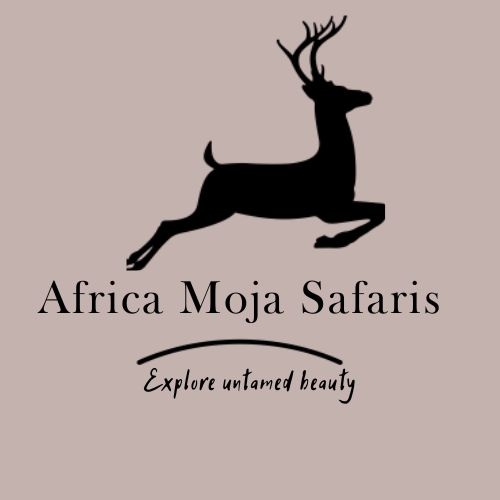
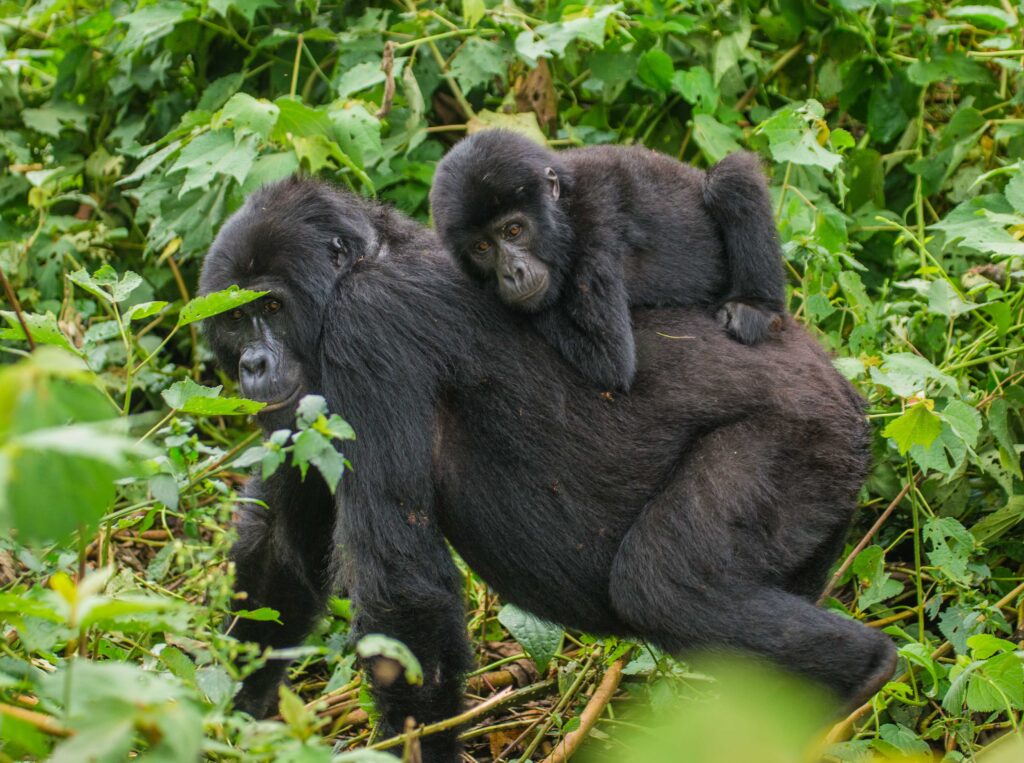
Pingback: Your guide to Gorilla trekking in Rwanda, 2024. - Africa Moja Safaris